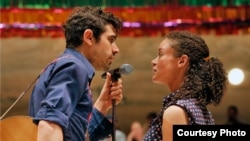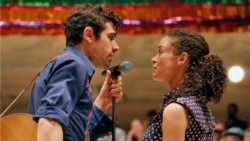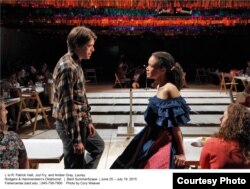The musicals of Rodgers and Hammerstein have been staples of the American theater since they were created in the 1940s and '50s. In just the last few years, South Pacific and The King and I have seen Tony-winning revivals. Now, a highly experimental version of their first musical is being staged at the Bard SummerScape Festival in upstate New York.
Oklahoma! was different from the beginning. When it opened on Broadway in 1943, songs and dances were not an integral part of the story in musical plays.
"Even though today we take it for granted that all the pieces of a musical work with each other, it was a bit of a revelation then," said Ted Chapin, who represents the Rodgers and Hammerstein estates. It's commonplace now to have every song connected to character, and to have dance numbers come out of the songs, "but before Oklahoma!, it was sort of unheard of."
On the surface, Oklahoma! seems like a simple story about a young woman deciding whether to go to a party with a nice young cowboy or a dangerous, lonely farmhand. But there’s a dark undercurrent to the story: The show is set at the turn of the 20th century, before Oklahoma became a state, when the territory was in social and political upheaval.
According to producer Gideon Lester, the composer and librettist understood this.
“There is no history of colonization or expansion or the building of nationhood that doesn’t contain violence in it," he said. "And Oklahoma! dramatizes that. Now, it does it in a way that is sunny and funny and full of beautiful music. And that juxtaposition makes that violence even more disquieting.”
An immersive experience
And disquiet is just what director Daniel Fish is after. To help the audience feel the musical’s conflicting emotions, he puts them close to the action. They sit at long tables on all four sides of the playing space, which is made to look like a community hall. There’s no chorus, or orchestra, just a six-piece band onstage. And the actors sometimes just speak their lines, sitting in chairs.
The staging of a crucial scene in which Curly, the cowboy, confronts Jud, the farmhand, is especially unsettling.
Fish said Hammerstein described Jud's gloomy hovel in detail — "that it’s dark, that it’s the source of a kind of sexuality and a kind of unknown. And so, well, how do you do that in this space? Well, sometimes the dumb answer is the best answer: Well, what will happen if we do the scene in the dark?”
Damon Daunno plays Curly and said the staging has an impact on the audience.
“It’s amazing how uncomfortable a bit of darkness [laughs] makes people — understandably — but it really changes the sort of spine in the room. You can really feel that," he said.
Where the production may be most controversial is at its end. The original play’s accidental death becomes a coldblooded murder.
Fish said this makes a deliberate point.
“It makes the community culpable and, I would argue, it also makes the audience culpable, as well,” he said.
And that, he said, gives them something to think about.
“You know, it’s an old story, but it’s also a story that matters now," he said thoughtfully, "in terms of issues of community, in terms of violence, in terms of how we create outsiders and in terms of love.”











